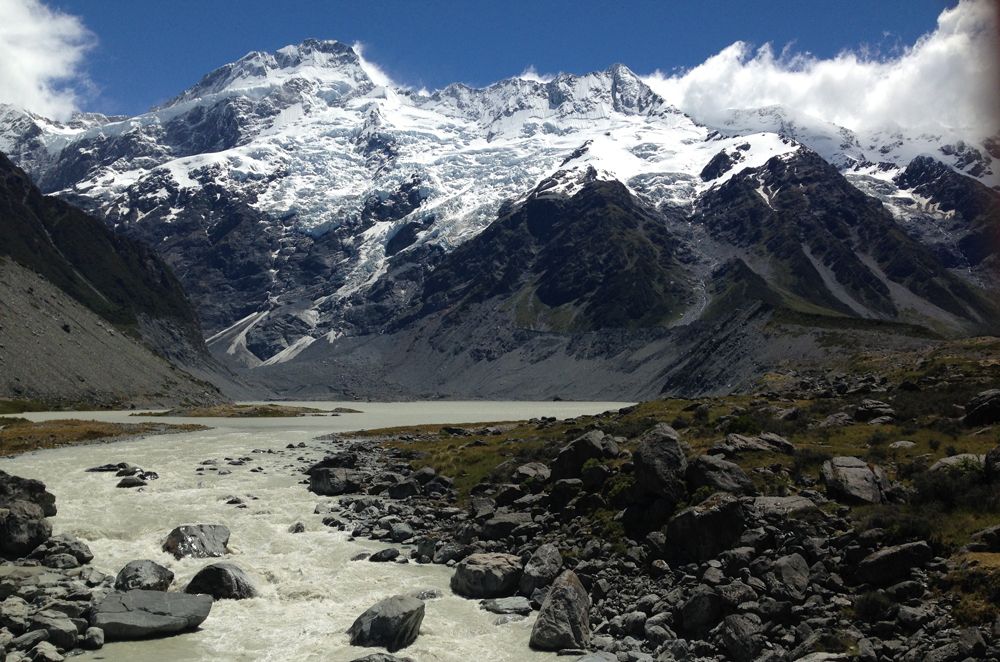New Zealand Dust May Have Cooled Earth During Ice Age

Tucked within the glacial valleys and streams of New Zealand's Southern Alps are heaps of iron-rich dust that may help explain why Earth's climate cooled during the last ice age.
Researchers recently traveled to these valleys for a monthlong expedition in which they collected dozens of dust samples to tease apart the story of Earth's last ice age, a cooling event that peaked roughly 22,000 years ago.
The dust was not the sole cause of the ice age, but likely helped contribute to and reinforce the cool temperatures, said Bess Koffman, a postdoctoral researcher at the Lamont-Doherty Earth Observatory at Columbia University.
"You can see that dust increases right at these climatic transitions, and so we think that dust is either an important driver or feedback in the climate system — or both," Koffman told Live Science. Ice cores dating back thousands of years, as well as marine sediments dating as far back as 4 million years, show that layers of iron-rich dust correlate with periods of climate cooling. [Images: New Zealand Dust Possible Source of Ice Age Cold]
Iron-rich dust is linked to cooler temperatures through the growth of plantlike organisms called phytoplankton. Large masses of iron-rich dust exist around the world as remnants of broken-down rocks. When it's loose and dry, this rock dust easily travels via winds in the atmosphere before settling on faraway landmasses or the open ocean. In the ocean, the dust fertilizes phytoplankton, which suck carbon dioxide out of the atmosphere during photosynthesis. Similar to garden plants on land, phytoplankton "bloom," or grow more rapidly, when fertilized, especially in regions like the Southern Ocean, where the ocean lacks iron.
When phytoplankton die, they sink to the seafloor and drag large quantities of carbon from carbon dioxide with them, gradually cooling the climate.
Where the wind gets its dust
Sign up for the Live Science daily newsletter now
Get the world’s most fascinating discoveries delivered straight to your inbox.
Researchers previously thought Australia would have been the most important source of dust to the Southern Ocean during the last ice age, since the continent is so huge. But Koffman's team thinks New Zealand's abundant glaciers may have made that landmass dustier than Australia. As glaciers carve through valleys, they pulverize rock into very fine-ground dust. That dust spills into meltwater streams that trickle out from beneath glaciers during warm seasons. When meltwater streams shrink during winter, silt dries up on shores and gets whipped up by wind.
Compared to cold, dry New Zealand, Australia was relatively wet during the last ice age and may not have emitted as much dust into the atmosphere, Koffman said.
The continent of Australia is also geologically older than New Zealand, so Aussie dust may have been more depleted of iron compared to the younger New Zealand dust that may have been a more potent fertilizer of marine phytoplankton.
"The soil material from Australia has been chemically weathered through time and is not going to be as rich in iron as the stuff coming from New Zealand," Koffman said. Still, the team does not know how much this would have impacted marine fertilization.
Koffman now plans to analyze her 75 dust samples to determine the chemical "footprint" of dust from New Zealand, to see if it matches up with the footprint of dust collected from Antarctic ice cores. If the two footprints match, then the team will have confirmed that dust traveled across the Southern Ocean and may have helped suck carbon dioxide out of the atmosphere along the way.
Koffman emphasized that the work is still in its preliminary stages, and that the team has not yet drawn any conclusions. The researchers are most concerned with establishing whether this dust did, in fact, traverse the Southern Ocean, and from there, they'll try to determine the extent to which it would have caused temperatures to drop during the ice age, Koffman said.
Follow Laura Poppick on Twitter. Follow us @livescience, Facebook & Google+. Original article on Live Science.












